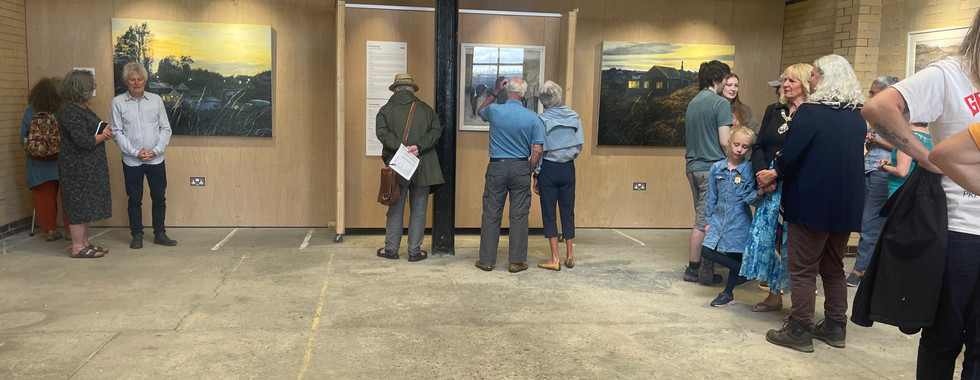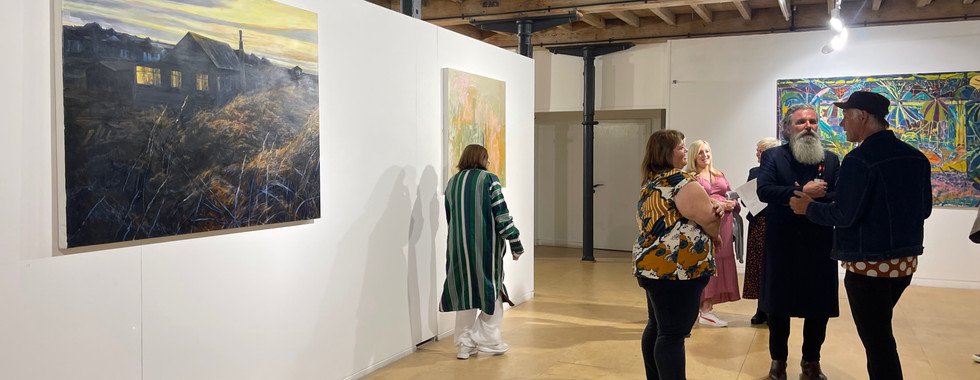Hideaway: further afield
- Judith Tucker
- Oct 1, 2022
- 7 min read
Updated: Nov 11, 2022

We are very pleased that excerpts of our work from the project Hideaway: painting and poetry from the saltmarsh had further exposure in other exhibitions, performances and papers in addition to those we originally planned, both during the official life of the project and beyond.
Surroundings at the Old Parcels Office, Scarborough
2nd -17th July 2022
“The Old Parcels Office is excited and pleased to be able to bring together the paintings and three-dimensional work of nine artists from across the Northern region that have in common an interest in our surroundings.”
Five of Judith Tucker’s Night Fitties series from Hideaway were shown alongside QR codes so that visitors were able to listen to Harriet Tarlo’s archivally inspired poems which were also read live in front of the paintings at the Private View.
Here are a few informal photos from the opening afternoon
Human : Nature at Linden Hall Studios
Several of Judith Tucker’s paintings were included in this exhibition
Human:Nature brings together seven painters, all of whom make paintings that could be considered, in part, to be a contemplation of our relationship with nature. How we experience it, our impact on it, and ways in which we understand and make sense of it. How can a painting be a response to these concerns, rather than something that is an attempt at overt depiction - a ‘landscape painting’ - in the traditional sense? The paintings in this exhibition range from works that can be seen as a response to the natural world in some form, to works that use ideas of ‘landscape’, or ‘nature’, as an armature to hang the painting on, or a vehicle for, the artists’ own personal concerns.
Beep Painting Prize 2022
Dark marsh: darkening reed was Shortlisted for the Beep Painting Prize exhibition, 2022, and was exhibited at the Nothing has changed, everything has changed at show at the Elysium Gallery, Swansea between 29th July – 10th September

Tears in the Fence Festival, Stourpaine, 2‐4 September 2022.
Harriet Tarlo was a featured poet at the Tears in the Fence Festival. The theme this year was ‘Bewilderment / Be-wildered / Be wild’ and Harriet talked about and performed the whole of the Saltwort artists’ book in this context, as well as answering audience questions. The festival was filmed, so there will be a lasting legacy of this on the festival website.

ASLE UKI Conference, University of Northumbria, Newcastle, 6-8 September 2022.
Harriet Tarlo performed poetry from Saltwort artists’ book at the Creative Writing showcase at ASLE UKI (Association for the Study of Literature and Environment, U.K. and Ireland) at this biennial conference. There were 50 of these delegates at the Creative Writing showcase and the conference as a whole was attended by c150 academics, writers and activists in the field of literature and environment. The book featured in the book exhibition at the conference, so was seen by many of these.
Paint Edgy: Contemporary British Painting and Guests at the Ropewalk Gallery,

Barton on Humber
This exhibition featured one of Judith Tucker's Dark Marsh paintings and she also contributed to Paint Edgy: Artists’ Talks
Paint Edgy: Contemporary British Painting and Guests. An afternoon of talks from exhibiting artists in which she discussed Hideaway.
EASCLE Conference, University of Granada, Spain, 12‐15 September, 2022.
Harriet Tarlo and Judith Tucker gave a paper entitled ‘SALTWORT: Poetry, Art and Plant Agency’ (which included readings from the Saltwort artists’ book) at the 9th Biennial Conference of the European Association for the Study of Literature, Culture and Environment (EASLCE) in Granada. This conference was attended by over a hundred academics, writers and activists from countries all over Europe. Our panel on plants was attended by 35 of these.
Festival of the Mind, Sheffield
We were able to discuss and display aspects of Hideaway alongside Royal Society funded project For Every Bird a Nest which ran in tandem with Hideaway. We gave a public talk in the Spiegel tent, had a mini exhibition and this video is a legacy of that.
Sample slides from the conference
Conference Abstract: Harriet TARLO and Judith TUCKER: SALTWORT: Poetry, Art and Plant Agency
In this paper, poet Harriet Tarlo and artist Judith Tucker present recent work from their Arts Council England funded project, Hideaway which included sustained practice-based research into East Coast Lincolnshire saltmarsh plant-life. The work is contextualised within Tarlo's consideration of thirty years of her own landscape poetry and thinking around plants in relation to that of other writers and artists who have influenced her through their writing such as William Wordsworth; John Clare; H.D.; Lorine Niedecker; Elisabeth Bletsoe and Thomas A. Clark. Key questions considered are: What can be the relationship of language and naming to plant-life - (how) is it possible to acknowledge, even represent, the agency and intelligence of plants as explored by recent thinkers such as Anthony Trewavas and John Ryan? Is it desirable or possible to move beyond botanical and ecological classifications and descriptions? What can cross-disciplinary and aesthetic exploration in space, sound, colour and science achieve in this area? Or might it be better to convey the mystery of what is not known than to attempt to encapsulate current "science" within "the arts"? How can wider concepts of time and place, such as localised context (place), seasonality and the symbiosis of all elements of the more-than-human world be adequately present in art and poetry? Finally, how do we erode hierarchical thinking to consider our own human minds in relation to the minds of plants in new and exciting ways, whilst remaining cognisant of the age-old cultural significance of plants to humans and retaining what is of value there? On the ground, in the particular case of the saltmarsh and the specifically adapted plants that grow there, we must recognise the threat such bioregions have been under from as early as Roman times when they first began to be "reclaimed" from the sea. Now modern developments, climate change and hard sea defences erode them even further threatening saltwort plants along with their habitats, though pioneering "colonisers" such as cord-grass and samphire are still taking back beaches and establishing sedimentation. It is important for humans to understood and to respect, not just the importance of these areas as permeable barriers to flood, but also the extraordinary ability of these plants to survive high and varied levels of salination in their respective zones of the saltmarsh as they make rooted and cellular decisions and take energetic actions necessary for their survival daily in relation to tide and weather. Perhaps, through artistic practice, landscape decisions might be influenced by interaction in person, in poetry and in art with these plants' lives below and above land, in water and, through dispersal, air.
A Rabblement Of Bone And Rot, Artworks, Shaw Lane, Halifax HX3 9ET
Four of Judith’s Hideaway paintings were included in this group exhibition in Halifax between 16 September - 14 October 2022
Artworks and Terrace Gallery present 'A Rabblement of Bone and Rot' curated by Karl Bielik and Rob Hall.
9 painters and 1 sculptor - from or based in the north:
Rebecca Appleby, Karl Bielik, Kate Boucher, Paul Branley, Jo Brown, Gordon Dalton, Terry Green, Rob Hall, Sarah Shaw and Judith Tucker.
Entwined: plants in contemporary painting: Exhibition at Huddersfield Art Gallery: Unit 7
9 November 2022 – 28 January 2023
Three large paintings by Judith Tucker which were developed out of the Hideaway project were included in this show, seen alongside a QR code which linked to a full reading of the artist book Saltwort. Harriet also gave a live poetry reading at the opening and a new booklet was produced to coincide with this exhibition. Dark Marsh: painting, poetry, plants. This slim volume introduces our saltmarsh collaboration and highlights our ACE Hideaway project. We are grateful to Phil Illingworth and IDprojects for the design and to Sheffield Hallam University for funding.
Entwined was curated by artist-curators Judith Tucker and Barbara Howey with Grant Scanlan (Curator at Huddersfield Art Gallery). The exhibition was supported by Royal Botanic Gardens Kew whose botanists provided another perspective on the artworks in the exhibition. It is a substantial development out of the Hideaway project.
The exhibition features artwork by leading British painters, including winners of the John Moores and Contemporary British Painting Prize. The artists are:
Amanda Ansell, Bryony Benge-Abbott, Hannah Brown, Graham Crowley, Sam Douglas, Michele Fletcher, Barbara Howey, Linda Ingham, Juliette Losq, Paula MacArthur, Iain Nicholls, Joe Packer, Julian Perry, Narbi Price, Harvey Taylor, Helen Thomas, Judith Tucker and Joanna Whittle.
The paintings in this exhibition invite their viewers to look closely at plants. They do this through the widest of ranges of approaches to paint, the selected painters all delight in our extraordinary vegetive world. This visual feast explores why painting plants matters now, using approaches from lyrical abstraction through to forensic observation of plants in crisis. How might this deep exploration of plants, through paint, help us understand our place in the world now? What does it mean to understand a locale through an intense study of what is growing close at hand? Of course, there is a provocation to slow down, to give attention to detail and specificity in all the works. This reflects our renewed relation with nature: those places we have come to value so much, where we go to catch our breath and connect to the more-than-human-world. Some of the paintings’ beauty belies darker and melancholic attributes, plants as symptom of loss, as metaphor for migration, the legacy of colonialism and as a contemporary take on memento-mori. For this invitation to look slowly and the focus on the specificity and minutiae of plants comes, paradoxically, at a moment of wider global trauma both in terms of the pandemic but also its corollary, global heating and alarming biodiversity loss.
The visual conversation that this exhibition engenders, with its focus on the up-close world of plants will be in dialogue with earlier scientific, aesthetic and design representations of plants. The works in the show work with and against the rich traditions of the many and various aesthetic traditions of depicting plants, from botanical illustration, to decoration and design, to a reversal and reworking of ideas of landscape painting as immersive rather than a view, and the focus on the fragility of more-than-human life specifically the endangered nature of plant species, is certainly a memento mori, but not just ours.







































Comments